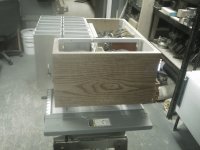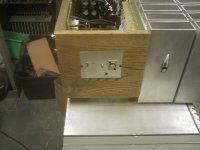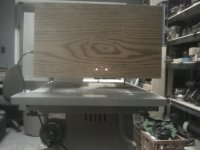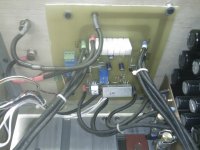Hi all
After scouring the internet, and this forum, there appears to be quite a few people that have started to build this monster amp, but unfortunately few that have completed one.
I would very much like to hear from diyaudio members, or anyone else that has completed one.
Looking forward to responses.
Kind Regards
George.
After scouring the internet, and this forum, there appears to be quite a few people that have started to build this monster amp, but unfortunately few that have completed one.
I would very much like to hear from diyaudio members, or anyone else that has completed one.
Looking forward to responses.
Kind Regards
George.
Hi all again
Looks like there's not to many in this camp.
What I was after, was to hear from members, with particular reference to what issues they had, what construction difficulties occured and generally what lessons they learnt, to stop me from making the same.
My reasoning is, that at this level, you probably dont want to make to many mistakes as failures could be costly, not to mention possibly spectacular.
I have looked at the Aleph 2.0 threads, as it would appear that several members have built this one.
At this stage, I have determined:
Power requirements,
Thermal considerations,
Protection measures,
Physical case logistics,
Soft start,
Matching of O/P devices,
I have completed the P1.7 preamp, and the X-Ono phono stage, and I am every happy with them
Now just to complete the final missing link.
Anyway, would be delighted to hear from members.
Regards
George.
Looks like there's not to many in this camp.
What I was after, was to hear from members, with particular reference to what issues they had, what construction difficulties occured and generally what lessons they learnt, to stop me from making the same.
My reasoning is, that at this level, you probably dont want to make to many mistakes as failures could be costly, not to mention possibly spectacular.
I have looked at the Aleph 2.0 threads, as it would appear that several members have built this one.
At this stage, I have determined:
Power requirements,
Thermal considerations,
Protection measures,
Physical case logistics,
Soft start,
Matching of O/P devices,
I have completed the P1.7 preamp, and the X-Ono phono stage, and I am every happy with them
Now just to complete the final missing link.
Anyway, would be delighted to hear from members.
Regards
George.
i made a set, and love them.
i got 4 800?va 65v torids and unwound the secondarys for good voltage. 150kuf per block.... kinda small, but under .08v ripple @ .5A per fet.
only trouble i had was blowing a few fets....forgot to change from current to volts on my fluke.
and matching the blocks... i was anal about getting signals to match one side to the other.
i ordered 150 irfp240pbf from newark (i get a discount) and about 2 times the parts needed for just in case. but it wasnt all that bad.
i etched my own boards and made my own case.
i added rail fuses and small indacator led for the same,and a bias cir.
the bias cir just is relay controled. a standby and normal setting, controled either by manual switch or preamps 12v out. it was so while not using the amps the bias went down to keep the blocks warm but not so much power drain. both normal and standby are fine tuned with a small pot inside, with the normal side having a extra pot in series ecsesable from outside the case for jacking up the bias up to .8A per fet.
there again matching one side to another was hard. i didnt want to have to get out a meter every time i jacked up the current to make sure r&l matched.
at stock current, sinks are hot, 45-50c ish. at my normal mode .5A/fet sinks are no higher than 57c and at max current i allow with the external pot, .8A/fet sinks are no hotter than 60c-65 ish. i dont run them that hot offten or for long.
i love them. i dont use them very often due to kids, only in the winter and when im listiening for crickit farts in the recordings of lps late at night.
but ive got 3 kids, 2 under 4 so time to sit and enjoy is not often.
they get the most use when people ask what the big blocks of metal are next to the speakers, they roll their eyes then listen.....i uasualy have to ask them to leave around 2am. and then help them find audio bliss cause there bestbuy bose and sony dosent cut the cake anymore.
i hope u finish them and love them as much as i.
1 peice of advice...if i may.
build them together. IE power sopply for both so on and on..
its a big undertaking.
i did one and then the next..with a year inbetween.
cause i let other projects start.
good luck happy jamming
i got 4 800?va 65v torids and unwound the secondarys for good voltage. 150kuf per block.... kinda small, but under .08v ripple @ .5A per fet.
only trouble i had was blowing a few fets....forgot to change from current to volts on my fluke.
and matching the blocks... i was anal about getting signals to match one side to the other.
i ordered 150 irfp240pbf from newark (i get a discount) and about 2 times the parts needed for just in case. but it wasnt all that bad.
i etched my own boards and made my own case.
i added rail fuses and small indacator led for the same,and a bias cir.
the bias cir just is relay controled. a standby and normal setting, controled either by manual switch or preamps 12v out. it was so while not using the amps the bias went down to keep the blocks warm but not so much power drain. both normal and standby are fine tuned with a small pot inside, with the normal side having a extra pot in series ecsesable from outside the case for jacking up the bias up to .8A per fet.
there again matching one side to another was hard. i didnt want to have to get out a meter every time i jacked up the current to make sure r&l matched.
at stock current, sinks are hot, 45-50c ish. at my normal mode .5A/fet sinks are no higher than 57c and at max current i allow with the external pot, .8A/fet sinks are no hotter than 60c-65 ish. i dont run them that hot offten or for long.
i love them. i dont use them very often due to kids, only in the winter and when im listiening for crickit farts in the recordings of lps late at night.
but ive got 3 kids, 2 under 4 so time to sit and enjoy is not often.
they get the most use when people ask what the big blocks of metal are next to the speakers, they roll their eyes then listen.....i uasualy have to ask them to leave around 2am. and then help them find audio bliss cause there bestbuy bose and sony dosent cut the cake anymore.
i hope u finish them and love them as much as i.
1 peice of advice...if i may.
build them together. IE power sopply for both so on and on..
its a big undertaking.
i did one and then the next..with a year inbetween.
cause i let other projects start.
good luck happy jamming
the bias cir just is relay controled. a standby and normal setting, controled either by manual switch or preamps 12v out. it was so while not using the amps the bias went down to keep the blocks warm but not so much power drain.
I've been thinking of creating some kind of stand-by function as well, as I want a quick warm-up for instant bliss.
Any pics?
I've been thinking of creating some kind of stand-by function as well, as I want a quick warm-up for instant bliss.
Any pics?
pic of amp or relay cir?
ive got my notes and my multisim scematics if you want them. amp pic here i go....to try to post.
these are of the first block at my office without the top
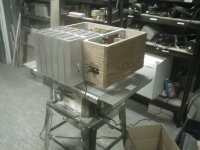
Thanks, sakellogg! (I guess you also get a discount on aluminum? -- Those rectangular tubes remind me of NP's BA chassis...)
I think I can imagine the bias stand-by relay circuit.
I think I can imagine the bias stand-by relay circuit.
closeup of input panel
bias switch... up is normal, led turns green....down red. the next pic will show 3 leds on the front. outside 2 are fuse indacators middle is the same as this one on the rear.
pots acsessable are the fine ajustment for the bias. course is on the board inside.
this was before i drilled the hole for the conector that makes it slave off the preamp.
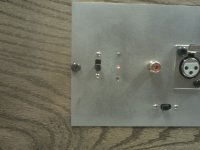
bias switch... up is normal, led turns green....down red. the next pic will show 3 leds on the front. outside 2 are fuse indacators middle is the same as this one on the rear.
pots acsessable are the fine ajustment for the bias. course is on the board inside.
this was before i drilled the hole for the conector that makes it slave off the preamp.

main board......the empty molex conector top left above relays is the pre input to turn up the bias. leaving the switch in the standby postion allows it to be slaved. 3 relays......if i remember right.......1 to select color of leds.
2 to bypass the switch (preamp in) and pick the 3rd relay in the middle that is the bias changer majigger. it all worked on paper and now for real.....but havent thought much about it. i have all my notes.
2 to bypass the switch (preamp in) and pick the 3rd relay in the middle that is the bias changer majigger. it all worked on paper and now for real.....but havent thought much about it. i have all my notes.
Attachments
fet spacing on the sinks. 2 fets per sink. each sink has 1 fet for current source and one output. sounded like a good idea at the time so heat would be more uniform to to bottom of the cir.........dose it make a diffrence? i dont know. but it sounds good huh? like my first marriage...sounded good at the time. i was worried about temp diff. from one fet to the other, cause they are all seprate, but i found that the diff in sink tep varied only 5degc @ the extrem most only 1 or 2 deg......dose that affect sound? i dont know. sounds good to me.
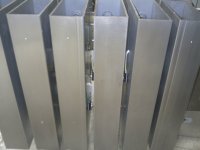

this one is the right chan. left chan is mirror image so the sinks face out from the speakers. i did it like this so it could sit right next to the speakers.
if i can help let me know, ill scan my notes.
oh and on boo boos... i also got my screwdriver across the shielding of the unbal input and one of the rails.....took out pfets 2 zeeners 1 current fet and...wait for it......my HP 651b test oscillator. i forgot about that!
but i had spare stuff and i learned how my 651 worked when i fixed it. i love the big plate caps in that thing.
anyway, there is my story.
i sent a email of thanks to nelson after making the first one. and i would like to say it again. I'm truly thankful for this opportunity to not only make something to enjoy but most of all, the stuff i learned is the best part. knowledge and time are the greatest gifts u can give. Ive learned that from my kids. and the guys on the pass forum and nelson share both freely, thanks.
p.s. i figured out the spell check...yay me.
if i can help let me know, ill scan my notes.
oh and on boo boos... i also got my screwdriver across the shielding of the unbal input and one of the rails.....took out pfets 2 zeeners 1 current fet and...wait for it......my HP 651b test oscillator. i forgot about that!
but i had spare stuff and i learned how my 651 worked when i fixed it. i love the big plate caps in that thing.
anyway, there is my story.
i sent a email of thanks to nelson after making the first one. and i would like to say it again. I'm truly thankful for this opportunity to not only make something to enjoy but most of all, the stuff i learned is the best part. knowledge and time are the greatest gifts u can give. Ive learned that from my kids. and the guys on the pass forum and nelson share both freely, thanks.
p.s. i figured out the spell check...yay me.
Thanks, sakellogg! (I guess you also get a discount on aluminum? -- Those rectangular tubes remind me of NP's BA chassis...)
I think I can imagine the bias stand-by relay circuit.
yes thats where i got the idea.
tubes are from crossing gates that have been hit. i cut out the unusable part and save the rest. i got the OK from my boss. otherwise we throw them away.
nice work there, great design and implementation
thank you, i enjoyed making them
- Status
- Not open for further replies.
- Home
- Amplifiers
- Pass Labs
- Pass Labs 1.2 Amplifier
